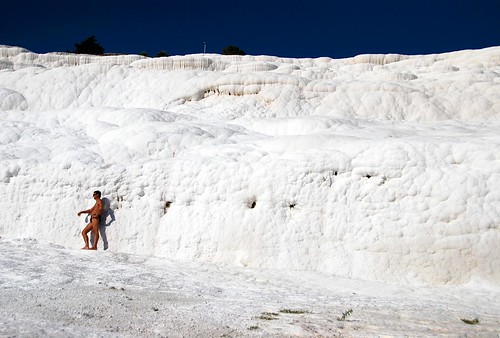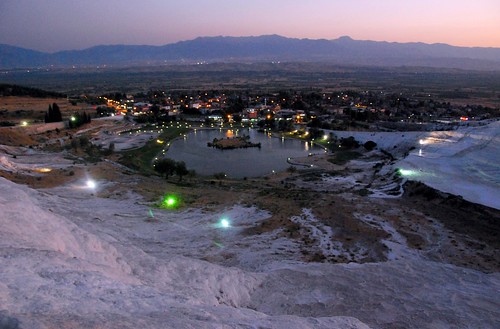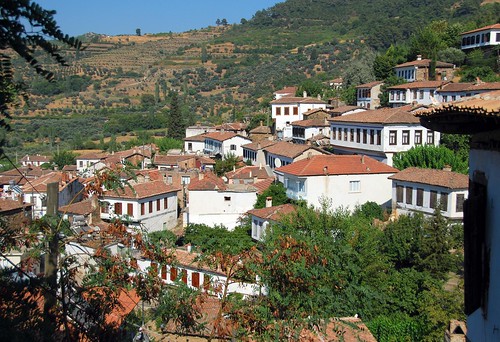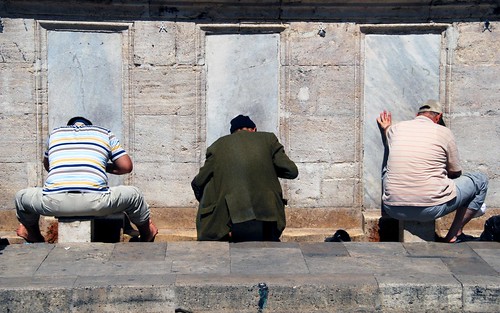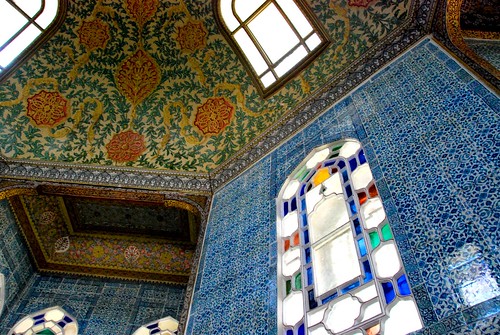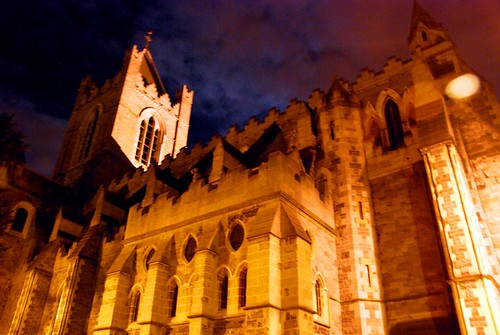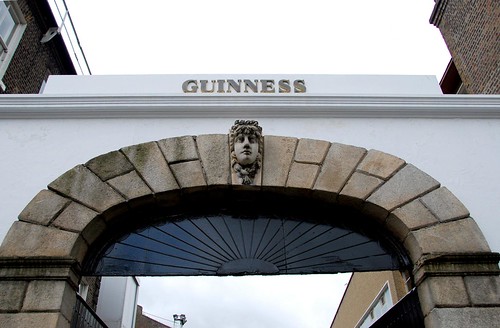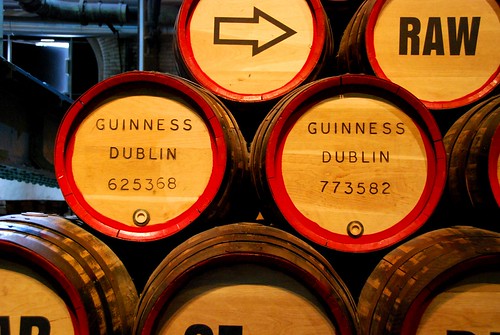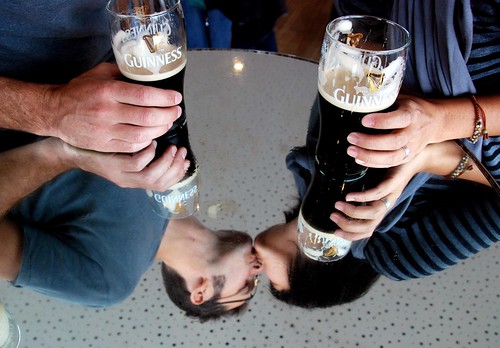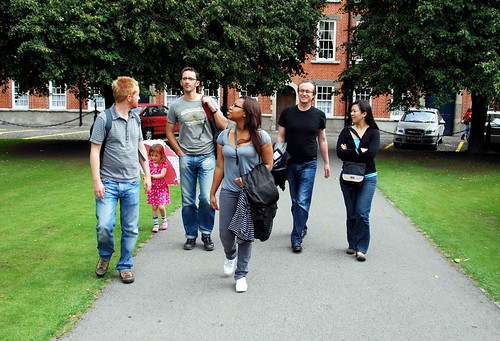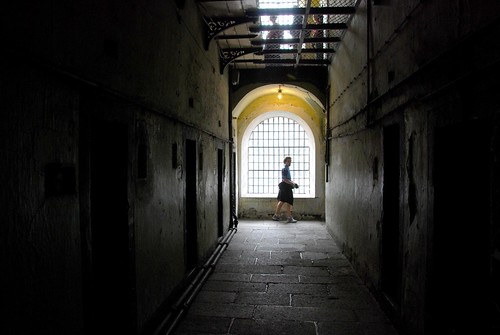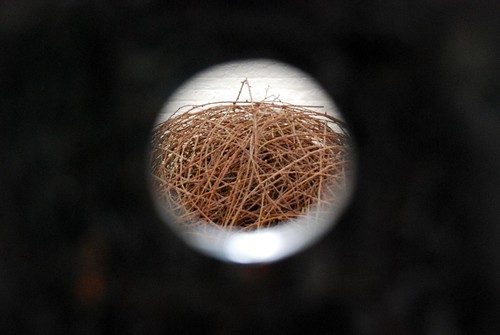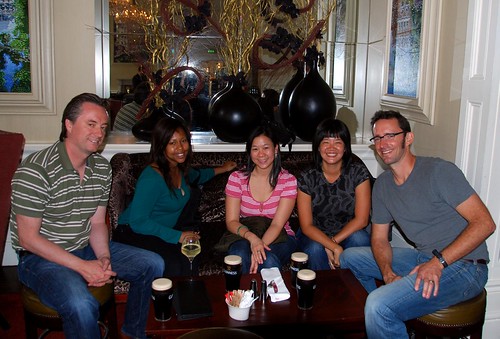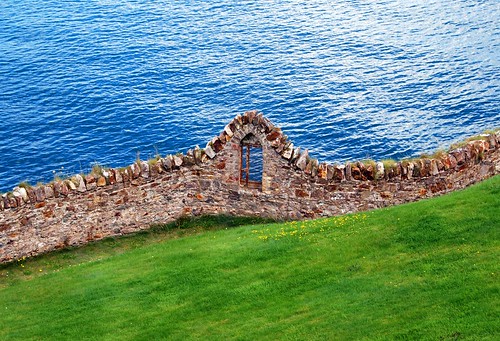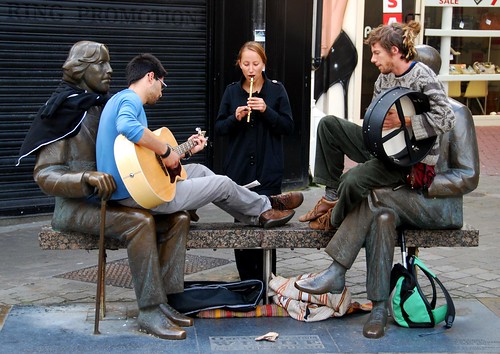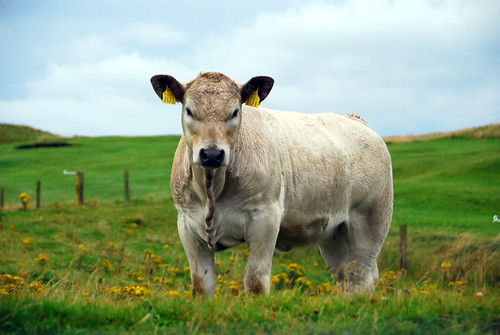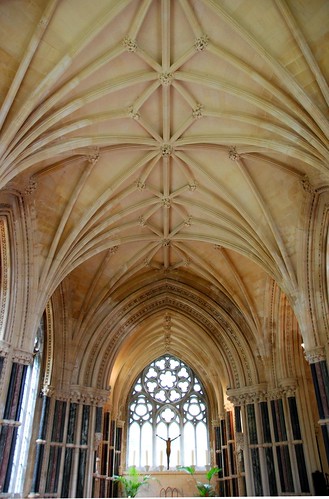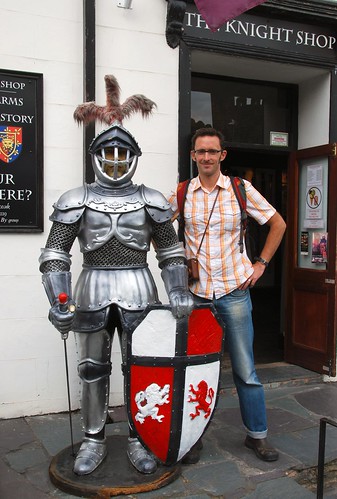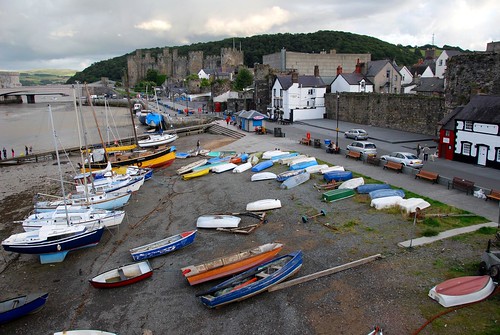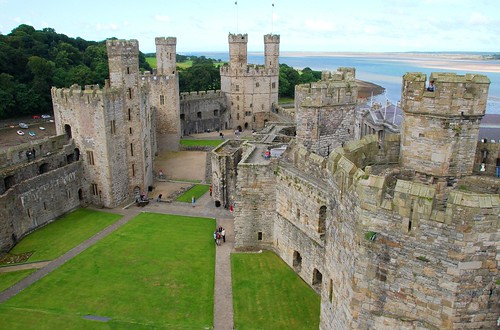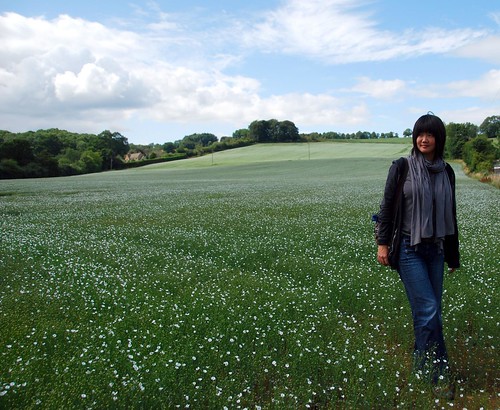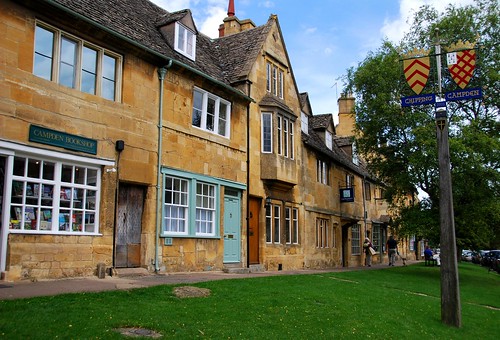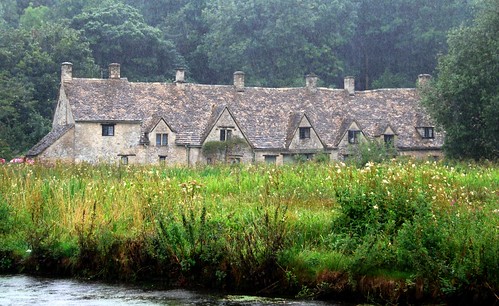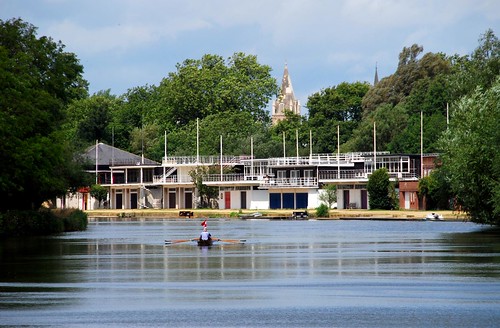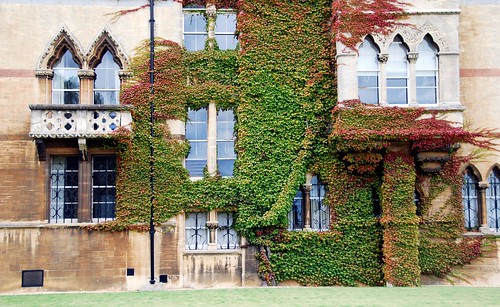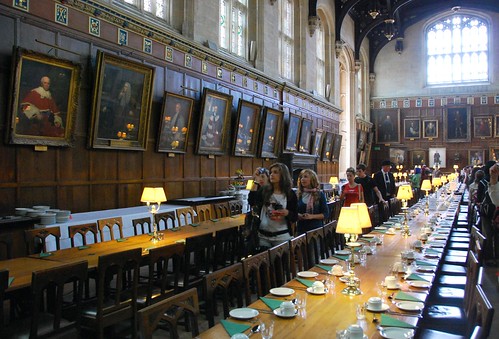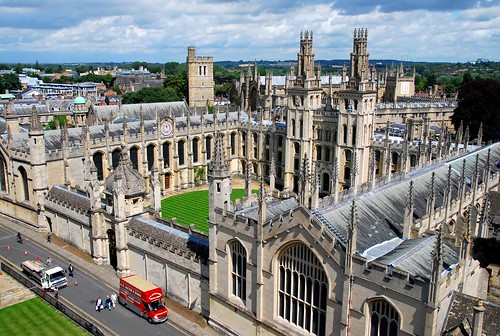Posts Tagged ‘blogsherpa’
Note: This post is dedicated to Sharon, who showed us incredible photos of Pamukkale waaay back in August of 2008. They were so incredible, in fact, that we said, “Holy crap! We have to go there!”
OK, remember that thing I said about us not being “ruins people”? I take that back. It turns out that we’re just not “Ephesus people.” In my last post, I alluded to the fact that we don’t really get excited by ruins unless there’s an incredible landscape to go along with it…and the reason why we know that to be true is because of our visit to Hierapolis and Pamukkale.
First things first: Hierapolis is another set of Greek ruins set in the hills above a site named Pamukkale. And what exactly is Pamukkale? Only the coolest travertines (white limestone made of calcium carbonate) we’ve ever seen! OK, maybe the only travertines we’ve ever seen. It looks like snow but it’s really rock.
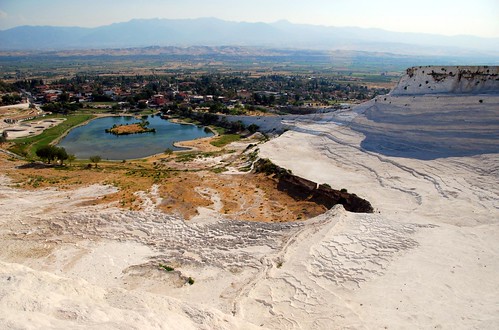
A bird’s eye view of the Pamukkale complex, with the town of Pamukkale in the background.
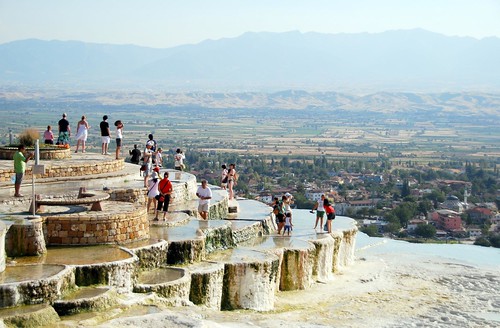
Tourists in the travertine pools.
J and I stuck to our usual M.O. and headed up to the Pamukkale/Hierapolis complex late in the afternoon, around 3PM. Unlike Ephesus, this time our plan worked—the huge crowds of Russian tourists in Speedos that flock to Pamukkale had already started filtering out of the complex, though a couple of them stuck around to pose for our photographs. ![]()
In order to get to Hierapolis, you must walk through Pamukkale’s travertine pools (barefoot, which can be pretty tough on your dogs, unless you have tough Aussie feet).
We couldn’t have timed our visit more perfectly! As we arrived in the Hierapolis area, the sun started going down, illuminating the dry grasses in the hills and creating the perfect golden light that plays a major role in every photographers’ wild, sordid fantasy.
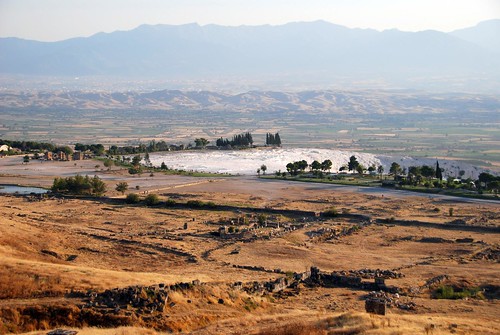
An interesting view of the travertines from the hills of Hierapolis.
This time around, we had a fabulous experience exploring Hierapolis. We got to see the remnants of an old city, including their main ceremonial street and the men’s toilet.
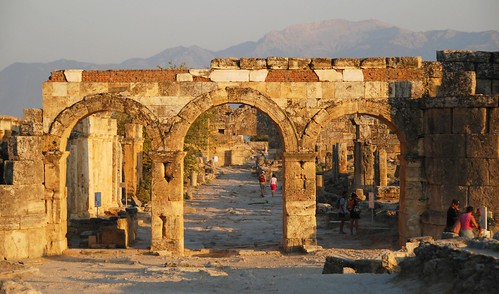
The Domitian Gate, entrance to the city of Hierapolis’ main ceremonial thoroughfare.
In fact, we were so entranced with Hierapolis’ HUGE ruins site that we almost missed the sunset! We scurried over to the travertine pools just in time to watch the sun dip below the horizon.

Sunset over Pamukkale’s travertine pools.
We’ve seen a LOT of really, really gorgeous sunsets on this trip, and—dare I say it? The sunset we watched from Pamukkale might be the best one of the trip thus far. This vistas from the top of the travertines and the golden light shining reflecting off the pools…INCREDIBLE!!! It as so awesome that we were feeling sorry for all the Speedo’ed Russians who missed this stunningly beautiful sight. We’re sensitive like that.
Since the sun had already gone down, we made our way back to town in the dark. But don’t worry—they light up the Pamukkale complex so you can still find your way down (though it was a rather painful descent with that rock).
We almost didn’t come to Pamukkale—it is a heavily touristed site and after our experience with the crowds in Ephesus, we were worried that we would be turned off. But as is the case in most situations, timing here in Pamukkale is everything.
How we got from Selcuk to Pamukkale: Paid 20 lira each for a “direct” bus from Selcuk to Pamukkale. And by “direct,” I mean we stopped in Denizli and changed to a minibus. We still haven’t quite figured out what “direct” in Turkey means…we’ve had “direct” buses that stop in every major town along the route and “direct” buses that make you transfer to a different bus. So as far as we can tell, as long as you work under the assumption that “direct” in Turkish means “indirect,” you won’t be disappointed.
Where we stayed in Pamukkale: As in Ephesus, we went with the hotel touts at the bus station and ended up at a place hilariously called The Four Seasons, also known by its Turkish name, Dort Mevsim (I say hilarious because on the way to the hotel, the owner kept passing backpackers and asking, “Are you going to The Four Seasons?” And these backpackers would look at him like, “Our clothes are riddles with holes and I haven’t brushed my hair in a month. Do I LOOK like I’m going to The Four Seasons?” Of course, little did they realize that “The Four Seasons” was actually an unfortunately-named backpacker hostel.
First of all, a note on the hotel touts: Turkish hotel touts are some of the most civilized we’ve ever met. They seem to have some sort of system, where each tout gets his turn to pitch the newly arrived travelers. No Vietnam-style crowding of the bus here! In Selcuk, the first guy who approached us named a price that was waaay too high for us. So he said, “meet my friend, he has a cheaper hotel for you.” Which is how we ended up at the Canberra Hotel. So gentlemanly!
Anyway, back to Pamukkale: we originally wanted to stay at a place called Venus Pension. The owner of The Four Seasons offered us a free ride on the promise that if we didn’t like that hotel, we would check out his place next. Classy!!! When Venus Pension turned out to be way overpriced, we went over to The Four Seasons (which was directly across the street) and agreed to stay there for 40 lira per night (US$25).
The rooms at the brightly-painted Dort Mevsim are very comfortable, and there is a nice pool (which we didn’t end up using) and a shady terrace where you eat breakfast. All in all, a great place, and if you book ahead online, it’s even cheaper!
Check out all our photos from Pamukkale and Hierapolis:
Selçuk is a very common stop on the Turkish backpacker route and it’s not hard to see why: it’s located on the Aegean but it’s pretty much the midpoint between Istanbul and the Mediterranean coast (located 9 hours from Istanbul and about the same from Fethiye), and it boasts some of the best-preserved Greco-Roman ruins this side of, well, Rome! We didn’t realize how many modern-day Turkish cities have a Greek or Roman history, but it makes sense, given Turkey’s location and the fact that the Roman empire pretty much dominated most of the lands around the Mediterranean at one point.
In fact, there are some pretty cool ruins right in town: the Selçuk Citadel and St. John’s Basilica.

View of the Selçuk Citadel, with St. John’s Basilica ruins in the foreground.
The coolest thing we learned from wandering these ruins is the fact that Romans often repurposed old construction materials (like columns) to build their cities. Romans—ancient architectural refashionistas!
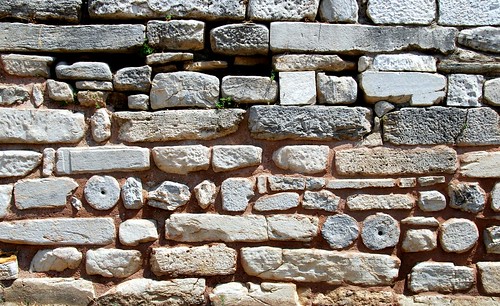
Bits of columns reused to construct the walls of St. John’s Basilica.
But the star of the ruins show is Ephesus, which is located right outside of Selçuk. It’s a neat place, with lots of major landmarks, and it allows you to imagine what life must have been like under the Roman empire.
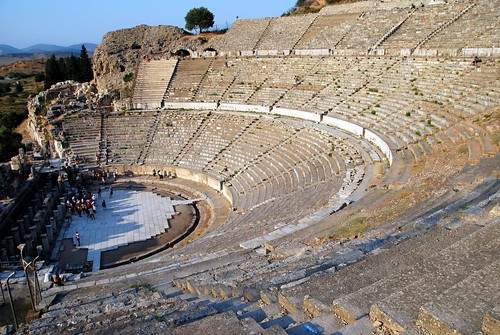
The Great Theater in Ephesus, where plays were acted out and gladiator battles fought!
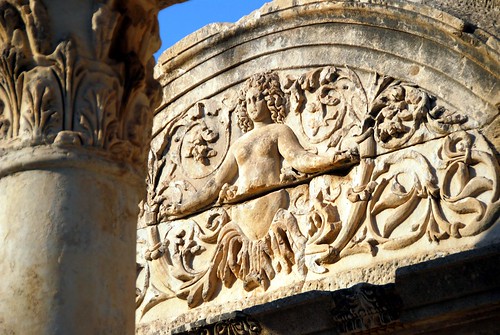
Detail, the Temple of Hadrian.
The crown jewel of Ephesus is the Library of Celsus, an imposing structure where the Romans stored thousands of “books” (i.e. scrolls). Like many classical structures (ex. the Parthenon), the design of the Library of Celsus employed some ingenious optical illusions to make the building appear more grand—the central entrance is larger than the other two flanking it, and the columns in the center are slightly bigger than the columns used on the outside of the building. The detail of the carvings on the library’s facade are really impressive.
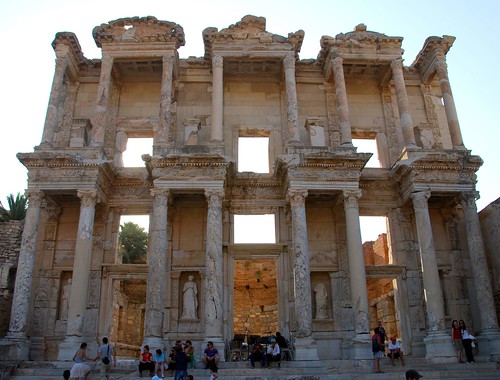
The crown jewel of Ephesus: the Library of Celsus, where the Romans stored thousands of “books” (i.e. scrolls).
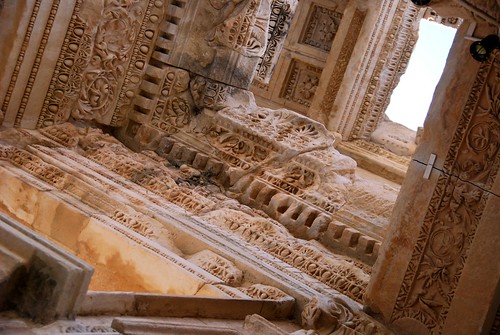
Detail, the Library of Celsus.
Our usual M.O. when visiting a major tourist site is to show up either right after opening or right before closing to avoid the masses, and we did the same with our visit to Ephesus—arriving only 2 hours before the park closes at 6pm. Unfortunately, it seems a tour group consisting of a bunch of very loud Italians had the same idea. So our experience of the ruins wasn’t that great—it felt kind of busy and loud and honestly a bit claustrophobic…but I guess that’s a pretty close approximation of what it would have been like to live in a bustling Roman city!
Most travelers stay in Selçuk for a day or two to see Ephesus before moving on. Since Selçuk was a pleasant enough town, we decided to stick around for another day and head into the countryside. A medium-sized town called Tire was having their local market on Tuesday, and though it wasn’t quite what we expected—lots of “made in China” clothing and goods—it put us within spitting distance of a town called Kaplan, where you can have lunch on the hill overlooking the town of Tire. Though the taxi ride to Kaplan made it kind of an expensive excursion just for a meal, the food was worth it! Turkey is one of the few countries in the world right now that supports its own food requirements—which is really awesome until you realize that means tomatoes, cucumbers, and olives are going to constitute the entirety of your vegetable diet. So we were understandably very excited when this beautiful little restaurant in Kaplan served us stuffed squash flowers, homemade yogurt, and a salad! With lettuce! And it was cheap (if you don’t count the taxi ride)!
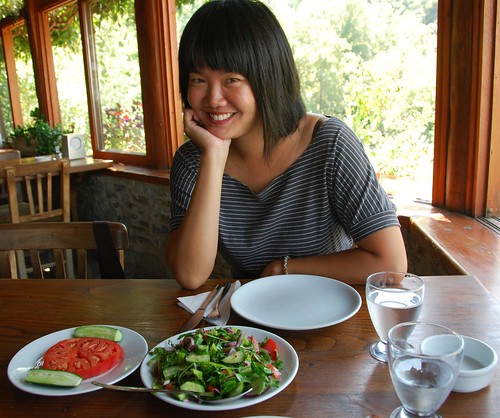
A salad worth a smile—lettuce! In Turkey! And not just some cheap iceberg—we’re talkin’ about dark green leaves in this salad!
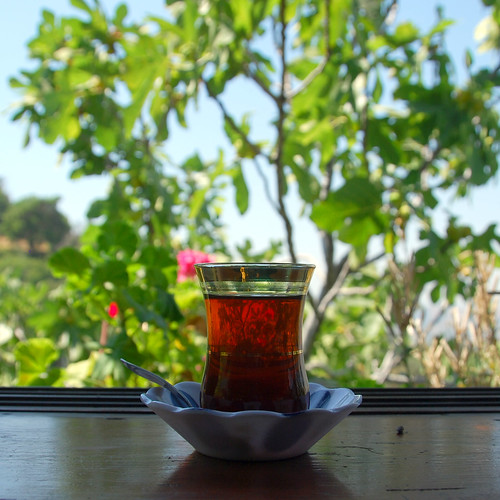
We drank this stuff all day long while we were in Turkey—Turkish tea.
Our next excursion wasn’t as successful—we heard that a town called Sirinçe was really beautiful, so we hopped the local bus (called a dolmuş) and headed for the hills. Unfortunately, it turned out to be a really lame town which was centered around a street full of shops selling tourist souvenirs. Some people are probably charmed by the whitewashed buildings, but this place was not for us.
We had a nice enough time in Selçuk, and if you’re really into ruins, then this is the place for you. I think that was the major lesson of our time in Selçuk—we’re not really “ruins people”…unless there is a really interesting landscape to go along with those ruins. ![]()
How we got from Istanbul to Selçuk: We showed up at Istanbul’s massive bus station and walked around to a few bus company offices until we found the lowest price (35 lira each from Istanbul to Izmir, where you can catch a van to Selçuk for an additional 7 lira). This was our first experience with Turkish buses—which have an excellent reputation—and the trip didn’t disappoint! A bus attendant wearing a bow tie, vest, and cummerbund (which matched the bus company’s colors!) serving us Turkish tea, cakes, and spring water on our 9 hour ride.
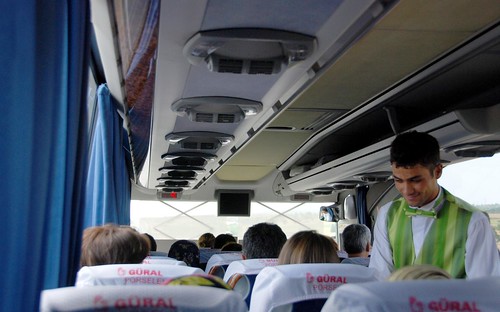
Turkish bus attendant serving tea and cakes on the drive from Istanbul to Izmir.
How we got from Selçuk to Tire, Kaplan, and Sirinçe: Took the local bus (basically a large van) from Selçuk to Tire for 6 lira and then a taxi from Tire to Kaplan (there is no public transport for this route). We also took the local bus to Sirinçe.
Where we slept in Selçuk: Turkish people are so amazing that we finally let down our guards, and for the first time on the trip, we went with the hotel touts at the bus station…and we weren’t disappointed! We stayed in a double ensuite at the Canberra Hotel for 50 lira (US$32). The room was very comfortable (and colorful!) and the views from the rooftop restaurant (where you have breakfast) were excellent. The hotel offers free rides to Ephesus, and since it is staffed by an enormous Kurdish family, inevitably some cousin or nephew will end up taking you to the ruins.
Ask any traveler about their experiences abroad and you’ll invariably get responses citing the opening of eyes, hearts, or minds. Travel IS the process of opening—exposing yourself to the influence of The Other, seeing great beauty through the eyes of another, and allowing yourself to be altered irreversibly by it.
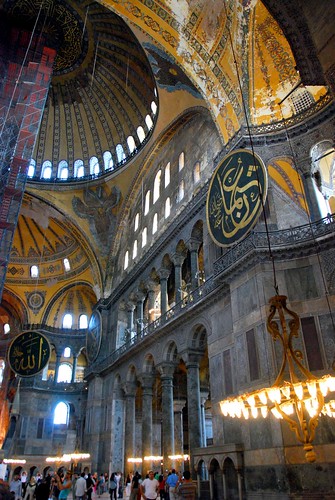
Talk about great beauty! The humbling interior of the Aya Sophia (Haghia Sophia).
Less frequently do you hear about the process of closing. I imagine it happens to most travelers at one time or another…take any open-minded person and subject them to constant touting and the less frequent but ever-threatening possibility of getting scammed or robbed, and most would end up with at least a bit of a shell—at best a wary eye, at worst a complete shut-down towards all interactions.

The Grand Bazaar in Istanbul. As a tourist, going to a market always opens you up to the possibility of an unpleasant interaction as all parties try to adhere to the old adage: buy low, sell high.
I’ll admit it: Jeremy and I grew a shell. After six months in Asia, we expected that any local who approached us on the street was trying to sell us something. We were most skeptical of those who didn’t lead with a sales pitch, but instead opened by asking where we were from or how long we had been in the country. We recognized the tactic for what it usually was—a lead to make us feel comfortable before the hard sell.
A week in Istanbul broke through that shell and smashed it into a million little pieces. Sure, there were people of the “Hello my friend, come into my carpet shop” variety, but the vast majority of our interactions with the locals here were surprisingly, I dunno, personal. If someone tried to sell us something and we politely declined, they still wanted to know where we were from, how long we would be in Turkey, and whether or not we were having a good time. It seemed like the Turkish people wanted to know all about us—even after we rejected their sales advance!

After months of Asians asking to take photos with Jeremy, in Istanbul, *I* was the celebrity. I guess they don’t see many 6 foot Chinese girls around here…
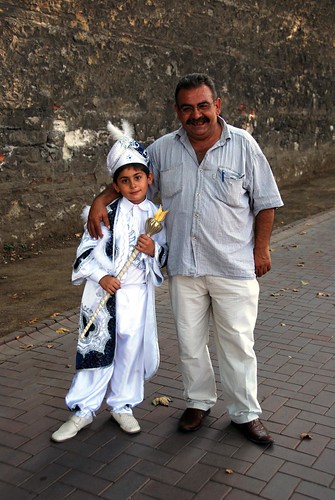
We were walking on the same sidewalk as these two when Dad proudly asked if we would like to take a picture of his mini-Sultan. Adorable!
Even in the Grand Bazaar, Istanbul’s most famous tourist market, it seemed like the selling was secondary to the bantering. To be fair, we met another traveler (who has been to Istanbul 8 times) who swears that the salesmen used to hassle you a lot more at the Grand Bazaar (he thinks that they government has instructed the sellers to back off). And, even though it’s off topic, it’s worth mentioning that we weren’t too impressed with the goods on display there (J and I walked through about 3 aisles before turning to each other and saying, “How much of this stuff do you think was made in China?”). But despite stall after stall of identical souvenirs for sale, our wanderings through this 500-year-old market were fascinating. Again, it was because of the people. One Turkish vendor in the spice market even engaged me in competent (though heavily accented) conversational Mandarin.

Spices in the (surprise!) spice bazaar.
Turkey is a stunning country. The landscape is incredible and the architecture can knock you off your feet. But despite all of this physical beauty, it’s the people—so full of love and graciousness that they could pierce through a 12FOOT3 shell—that will really get to you.
After 3 years of art school and 2 years working at a boutique graphic design studio, there is one rule that emerges: a rule so highly regarded in the industry that ignoring it would be like asking Thomas Keller to pair his fine steak with Two Buck Chuck. That rule is:
OBEY THE WHITE SPACE.
Any accomplished designer will tell you that the white space on a page is as important—sometimes even more so—than the text or graphical elements. It lets the eye rest, or gives it direction. It can create balance between the other elements on the page. In the best designs, it can create meaning.
Istanbul laughs in the face of white space. It thumbs its nose at white space. Indeed, Istanbul ran that white space right outta town.
The results are insanely beautiful.
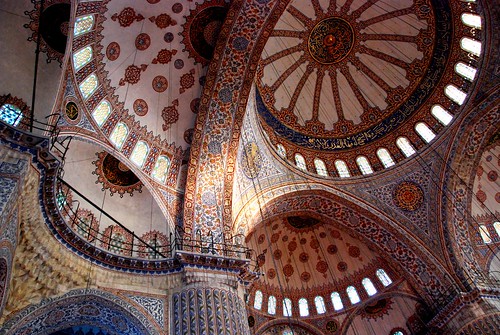
The ceiling of Sultanahmet (The Blue Mosque).
We spent most of our days with our necks craned up and our jaws open in awe. When I was in Oaxaca a few years ago, I was obsessed with all the beautiful patterned tiles. But THIS…this takes it to another level entirely.
Every surface that can be covered with a pattern, is.

Mother-of-pearl inlaid door at the Blue Mosque.
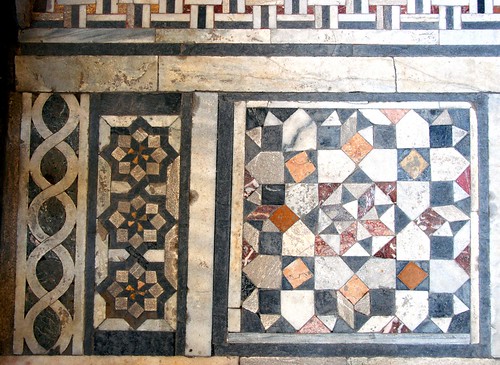
Stone floors at Topkapi Palace.
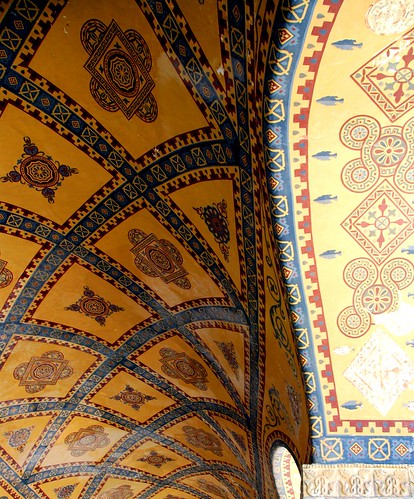
Painted ceiling in the upper gallery, Haghia Sophia (Aya Sofya).
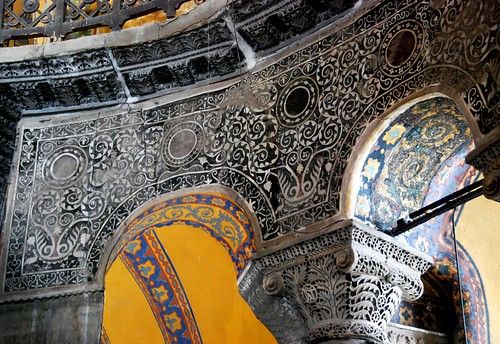
Byzantine arches and pillars at the Haghia Sophia (Aya Sofya).
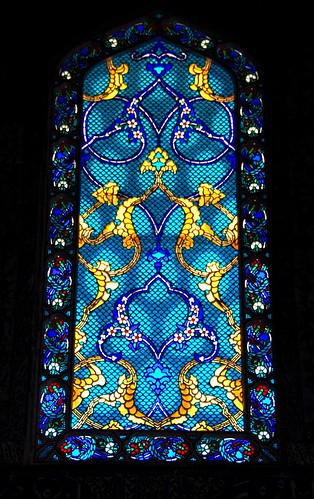
Stained-glass window, Topkapi Palace.
And what is in between those patterns layered on patterns? Is it enough to execute patterns in stone, tile, glass, wood, and paint? Of course not! Let’s throw some mosaics in there while we’re at it.

Virgin mother and child mosaic in the half-dome, Haghia Sophia (Aya Sofya).
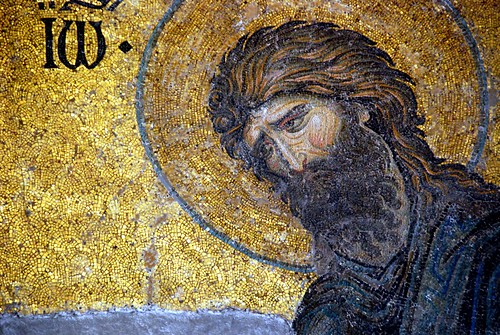
The Deësis mosaic in the Haghia Sophia (Aya Sofya).
Screw white space.
I finally started drifting off about 1:30AM, after another night gathered around delicious Guinness pints with our friends Chi-Chi, Conall, and Mariam. A bunch of random musicians had gathered in the pub to spontaneously play some tunes for the benefit of the pub’s patrons, and their music still played in the back of my mind as I thought of all the things we had seen in this enjoyable yet cozy city:
Beautiful Christ Church Cathedral (one short block away from the apartment where we stayed)…
Christ Church Cathedral at night. Creepy!
…the fun but information-light Guinness Brewery tour…
The actual St. James Brewery Gate!
Barrels at the Guinness Brewery. (This was the most interesting part of the Guinness tour—we spent an inordinate amount of time watching historic videos of barrel-makers using primitive tools to cut strips of wood into perfectly sealed, air-tight barrels. Amazing!)
A tender moment, reflected off the mirrored tables of the Guinness brewery’s Sky Bar—your reward for making it through the brewery tour. ![]()
…a walk around the grounds of Trinity College, where Conall’s brother Brian so generously acted as our tour guide and we got to see The Book of Kells…
Our 90210 moment at Trinity College. From left to right: Brian, his daughter, Jeremy, Mariam, Conall, and Chi-Chi.
…and our interesting visit of Kilmainham Gaol (that’s how they spell “jail” in Ireland, England, Australia, and New Zealand!), where we learned a ton about Irish history…
A local artist’s installation in one of the prisons’ cells. This piece features a giant tumbleweed that fills up the entire cell—emphasizing the stifling nature of captivity, as tumbleweeds are meant to exist in wide-open spaces.
Dublin is a place that is hard to capture in photos. It’s a place that is more felt (by roaming the streets and soaking up the ambience) than toured, more heard (in the music coming out of the pubs) than seen.
Wandering Dublin’s streets at night, looking for a warm pub and some good music.
On that note…just as we entered into deep sleep—
REEEEEEEEEEEE!!! REEEEEEEEEEEE!!! REEEEEEEEEEEE!!! REEEEEEEEEEEE!!!
Wha? GOOD LORD WHAT IS THAT NOISE?!? That can’t be—is that a FIRE ALARM? At 2:30AM? Jesus, someone turn that off!
Turns out some drunkards in our building pulled the fire alarm. OK, where were we? Oh yes, Dublin is also a place best experienced with friends. There are groups of people wandering the streets all night…in fact, the whole city feels like your friend sometimes—the Irish are the world’s best banterers and everyone seems to have a line or two to start a conversation.
Commemorating our final pint in Dublin with Conall, Mariam, and Chi-Chi.
Speaking of which—
[LOUD MUSIC, MUFFLED SOUNDS OF A PARTY, PEOPLE SHOUTING, HEAVY FOOTSTEPS]
At 4AM, we get another wakeup call, this time from the raucous party going on upstairs. I am wiling to bet that they are the same drunken idiots who pulled the fire alarm. Where are my earplugs?
BONG BONG BONG BONG BONG BONG BONG BONG!!! BONG BONG BONG BONG BONG BONG BONG BONG!!!BONG BONG BONG BONG BONG BONG BONG BONG!!!
OMG, what time is it? 9AM? Why are the bells of Christ Church going off so early? And when is it going to stop? (The answer: whenever you get your hungover butt into that church).
Sigh, just another Saturday night in Dublin… ![]()
How we got from Galway to Dublin: We took the GoBus from the western end of the country to Ireland’s eastern capital…for only €10 (approx. US$12.50)! The bus was comfortable, but the real reason why it was so cool—the bus had wi-fi! So fancy! You need to book your trip ahead of time on the internet in order to get this fare…and if you book early enough, you may even make the trip for €5.
Where we slept in Dublin: Since there were 5 of us, we decided to split a 2BR apartment in Christchurch Hall (booked via stayDublin.com), well-located a block away from Christchurch Cathedral. The apartment was clean, well-stocked, and had more room per person than your average Dublin hotel room. At €38 per person, it was a bit spendier than most hostels in Dublin, but it works out well for groups. Just watch out for the bells on Sunday AM and the drunk partiers before that!
Before our friends arrived in Dublin, J and I spent one night in the Jackson Court Hotel. We chose this place for its cheap price (only €50 for a double ensuite, with Irish breakfast included), and we probably should have been curious why the price was so low. Turns out this hotel is also the site of Copper Face Jacks Night Club. The hilarious Wikitravel entry describes it in the following way: “…Known in the fine Dublin phrase as a Meat Market this night out is crammed with people desperate to score and getting more and more willing as they consume more booze.” Read the full entry here (under the “Clubs” subhead). The hotel actually gives you earplugs when you check in. Luckily, our room was located on the top floor, so we weren’t too disturbed by the revelry, but light sleepers beware.
We arrived in Dublin a day before we were to meet our friends Conall, Mariam, and Chi-Chi, so J and I decided to get out of town and head up to the Howth peninsula (about 9 miles north of Dublin) for its famous cliff walk. It seems we got a cosmic payback after all those severe weather days in Galway, because the sun was out and the sky was the most glorious shade of blue during our day in Howth.
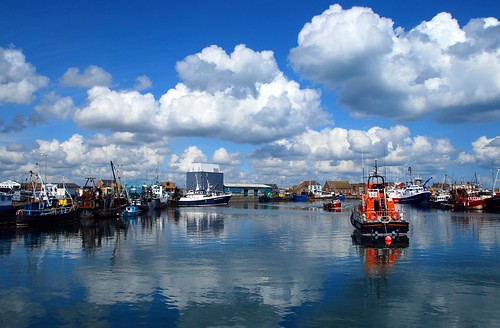
Howth harbor. Can you believe that sky?!?
In addition to our luck with the weather, it seems our timing was perfect to see this little town on Ireland’s east coast—the peninsula was exploding with wildflowers in shades of sunny yellow and deep magenta.
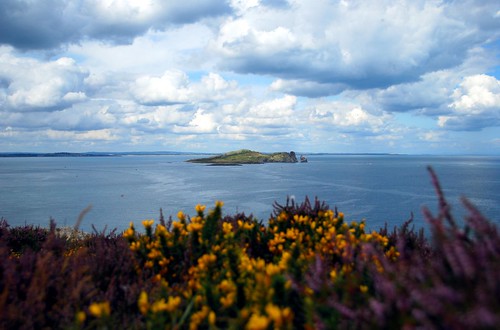
Wildflowers, and an island off the coast of Howth.
It took us about 4 hours to walk the entire loop, and we pretty much hiked the entire thing straight since there wasn’t an obvious place to rest on the trail. Needless to say, we were pretty tired by the end of it, but the walk was definitely worth it—what a stunningly beautiful landscape!
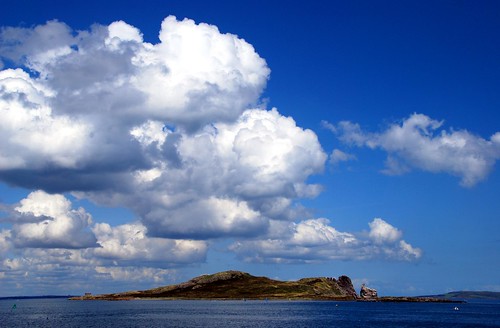
Ireland’s Eye, an island off the coast of Howth. You can take a boat from Howth to the island and explore its ruins.
Towards the southern end of the Howth cliff walk, you can see sailors and other wind-sport enthusiasts out for the day in Dublin bay.
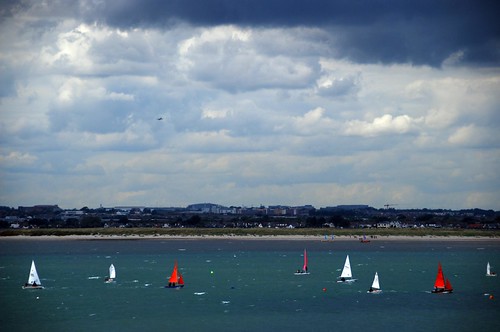
Just in time—clouds rolling into Dublin Bay at the end of our hike.
We were very glad we got out to this corner of Ireland, as Howth let us see a different side of this country than Athlone, Galway, and Dublin. And it always feels good when you earn your pint, doesn’t it?
How we got from Dublin to Howth: We took Dublin’s efficient and affordable DART train up to Howth. We love it when a city’s public transport works well!
As a visually-oriented person, most memories of the places we’ve traveled come back to me in snapshots: that incredible field of wildflowers near Milford Sound in New Zealand, beautiful children trying to sell us trinkets at the Temples of Angkor in Cambodia, the infinite abyss of ocean off Shirahama in Japan. Despite my visual leanings, my memories of Galway are of the aural variety: looking back through our snapshots of this charming town on the west coast of Ireland, I can hear the music playing to each of our photos.
Ireland has a very strong musical culture, and Galway is often referred to as the epicenter of that culture. Everywhere you go in Galway, there is music. You can hear it in one of the many beautiful pubs, where there are live musicians playing every night…
…or walking down the block, where street musicians entertain the masses for a Euro or two:
There’s also the not-so-obvious music playing in the background of our Galway photos. The cry of seagulls as the cold, black ocean crashes into the magnificent Cliffs of Moher:
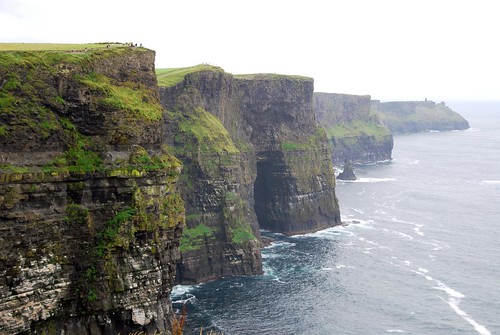
The Cliffs of Moher (aka The Cliffs of Insanity from The Princess Bride—yes, really!). To get an idea of the scale of these cliffs, look at the top left corner of the photo—there are people standing on that crag!
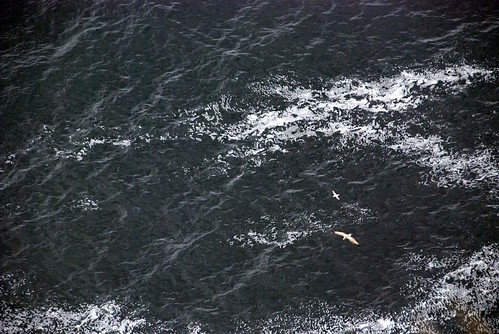
Seagulls flying over the cold, black sea.
The sound of happy cows grazing in the Burren:
The echo of our footsteps through the gorgeous Gothic Church in Connemara:
And of course, quite possibly the happiest music in all of Galway—a delicious pint of Guinness being poured in harmony with the slurping of oysters:
How we got from Athlone to Galway: Hitched a ride with Conall and his girlfriend Mariam!
Where we slept in Galway: We stayed at Dunaras Village, which is basically student housing converted into short-term stay apartments in the summer. The place was very comfortable and spacious, and at €45 per night for an apartment with full living room and kitchen, it was quite affordable by European standards. The only problem was, since it was located outside of the town center, we had to take the bus into Galway, which was at times difficult to negotiate since the bus doesn’t run that frequently. In short: Dunaras Village would have been absolutely perfect if we had a car.
We all have a little kid inside of us, don’t we? Hey, I’ll admit it: my inner child still loves playing dress-up and eating the heads off of gummy bears. Well, Jeremy showed me exactly what his inner child always dreamed of when, on a whim, we decided to head up to Northern Wales for a few days. The promise of castles and old city walls around a town called Conwy had Jeremy’s inner child squealing with delight. Even better: we would be sleeping in bunk beds at our youth hostel (and I let him have the top bunk). Castles, swords, city walls, AND bunk beds? I am pretty sure that 10 year old inside of Jeremy just had his mind blown.
Conwy is a lovely little town located on the coast of North Wales. We rolled into town in the late afternoon, with enough time to walk the old city walls, which enclose this little fishing village by the sea.

The view from atop Conwy’s old city walls.
The following day, we prepared to invade not one but two castles. The first, in a little town called Caernarfon, is (like Conwy) another picturesque little town by the sea famous for its lovely views from atop its lovely castle.
Entering the castle, I noticed that most visitors had kids with them. I felt a bit silly when we got up to the ticket gate and asked for “two adults.” That is, until I saw the look of glee in Jeremy’s eyes. The joy in his inner child’s heart was just priceless. I even felt like a proud parent as he ran around shooting fake arrows through the castle’s many “murder holes” (yes, that’s what they’re called).
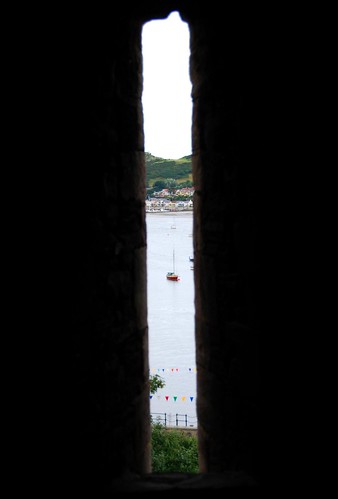
View through one of Caernarfon Castle’s murder holes.
Though not as large, Conwy’s castle is equally impressive. Tucked into a corner of the square created by the city walls, the castle allows beautiful views of the town and the sea.
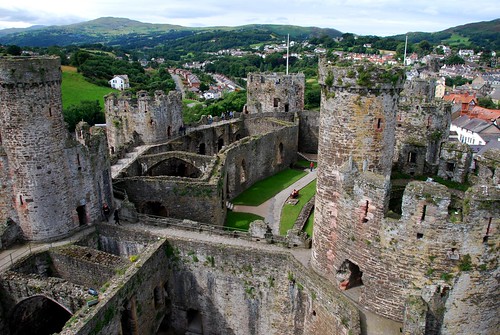
Conwy castle, with views of the surrounding city and countryside.
We learned quite a bit about the United Kingdom from our visits to Conwy and Caernarfon. In fact, these castles were built not to protect the Welsh from invaders, but to project English King Edward I’s power into Wales. Charles was crowned Prince of Wales at Caernarfon Castle (as all that are next in line for the throne), a kind of reassertion of the UK’s dominance over Wales. See, like Northern Ireland, Wales wants it’s independence. And it makes sense why they would—the Welsh have their own traditions, their own food, and of course, their own language. Speaking of which, Welsh is crazy! One look at the written word and you know that Welsh has absolutely no relationship to Latin. The Welsh language looks like it was created when someone accidentally rested their elbow on the keyboard. Ddwylodd. That’s probably a word in Welsh.
All joking aside, even though they do not express their desire for independence in a violent manner, this is a pretty serious issue for many Welsh people. Quite frankly, before our visit, I knew very little about Wales. Perhaps this was ignorant of me, but my impression of the UK was most closely associated with England: you know, Big Ben, powdered wigs, and bucolic countryside scenes like those we saw in the Cotswolds. I knew that Scotland and Northern Ireland were quite different culturally from England, but I didn’t have a sense of Wales. I certainly didn’t realize how distinctly different the four “home nations” of the UK (England, Scotland, Wales, and Northern Ireland) would be. I am humbled and continually amazed by the number of things we learn from our travels. Without this experience, there are so many details and intimacies I never would have known about this world!
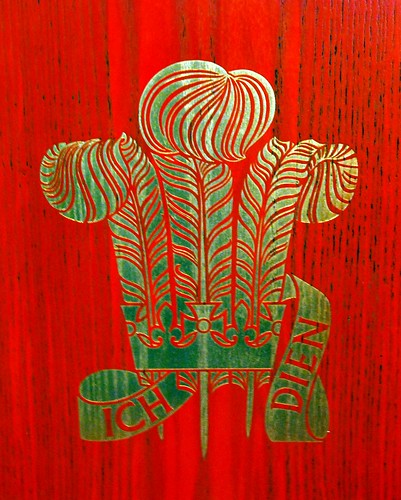
The Prince of Wales’ Feathers, a royal badge which is controversially used by the royal family to symbolize Wales.
Not only is Wales it’s own animal culturally, but physically the landscape is quite different too. Of course, it is much wetter in Wales than in England (though luck was on our side in Wales—we had rain only one morning during breakfast and it was glorious sun the rest of the time we were there!), but the North Wales area is also home to the tallest mountain in both England and Wales: Mount Snowdon. Whereas we saw gentle, rolling hills in the Cotswolds and Oxford, Northern Wales has some pretty dramatic mountain scenery.
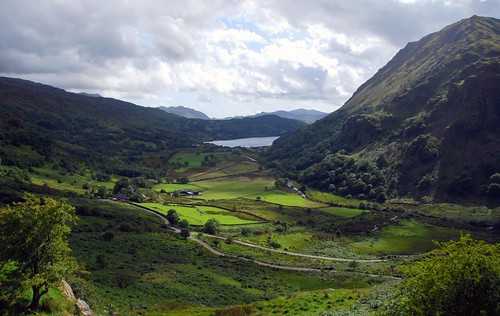
The Welsh countryside near Snowdonia National Park.
But Northern Wales isn’t just about big mountains and castles. As part of our entrance ticket to Conwy castle, we also saw an old Elizabethan house called Plas Mawr, which had fascinating displays detailing life in the Middle Ages. They had info on everything from the sewer system to strange medical procedures to toilets to diet. It was incredibly interesting, and the house wasn’t too bad looking, either!
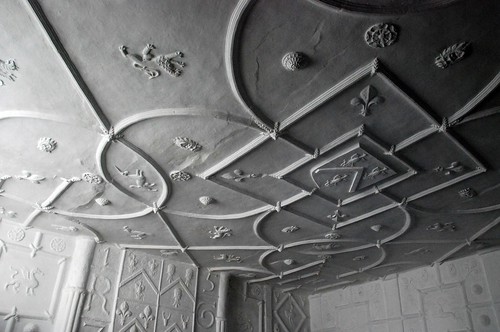
I was totally obsessed with the decorative plaster work covering the walls and ceiling in Plas Mawr.
What a wonderful time we had in Conwy and Caernarfon! Old city walls, castles, verdant mountain scenery, and old Elizabethan houses…turns out North Wales had more than a few things to appeal to my inner child as well. ![]()
How we got from the Cotswolds to Conwy: Conway is a 5 hour drive northwest of the Cotswolds, and this had many people in our B&B on edge. “Oh, Conwy’s very far, you’d better get a move on!” “Be careful, you can always pull off to the side of the road if you’re tired!” We were like, “Um, we’re from California…we do 5 hour drives in our sleep!”
Where we slept in Conwy: We stayed at the Conwy YHA, which was located up the hill outside of the city walls. Even though it was kind of hike out of town to get back to the hostel, the views were stupendous! The hostel itself was clean and comfortable, thought our room was very tiny, and they charged extra for towels. I think staying at a B&B in town might have been better value…though you certainly won’t get the same vistas.
[ring ring]
Cotswolds B&B Keeper: Six-five-zero-seven-seven-three? [Author's note: I spoke to at least three B&B owners in the Cotswolds who answered the phone like this—by reciting their phone number. Weird!]
Hope: Hello? Is this Warwick House Bed and Breakfast?
CB&BK: Indeed it is.
H: I was calling to see if you had any double rooms available for tomorrow night and if so, how much it costs.
CB&BK: Why yes we do. It’s £60 for a double room, including breakfast. Would you like me to reserve the room for you?
H: Let me call you back in a bit, I’m just asking around right now.
CB&BK: Right you are.
H: Thank you!
CB&BK: Cheerio!
“Right you are”? “Cheerio”? Really?!? People really talk like this?!? AWESOME!!!
The United Kingdom continues to surprise. First it was London, which I mistakenly thought of as too vanilla. Thousands of Middle Easterners, Europeans, and Africans living in the city proved me wrong on that assumption. This time it’s the Cotswolds, a region about 2 hours northwest of London in the countryside, showing me just how English England can get. Now I understand where they those halcyon scenes of the English countryside you see in the movies come from. Rolling hills? Check. Little old ladies pushing carts to the market? Check. Stone cottages with thatched roofs? Check and double check. It’s all right here, in the Cotswolds.
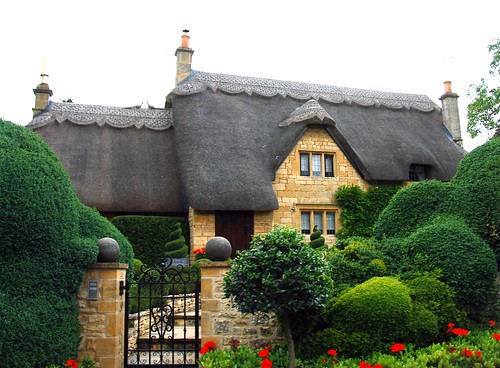
House with a thatched roof in the Cotswolds. This one in particular has a nice “haircut.”
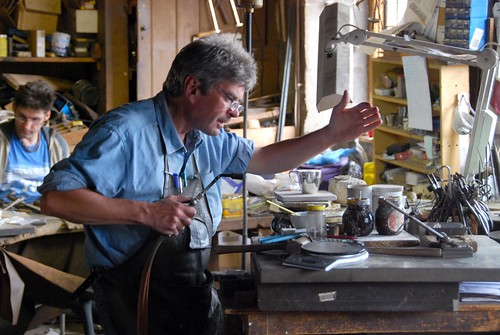
A traditional silversmith hard at work. Doesn’t this photo look like it came come straight from some PBS show or something?
The Cotswolds is a collection of little villages with awesome names like “Bourton-on-the-Water” and “Stow-on-the-Wold,” scattered between acres of lush green hills and rolling terrain. Most of the buildings in this area are built with “Cotswolds stone,” which is the most gorgeous golden yellow color:
By far the cutest village is Bibury, with adorable slate-roof houses set upon a babbling river. Unfortunately, it was raining pretty hard while we were there, so we didn’t really get to explore.
Our first night in the area, we stayed in Moreton-in-Marsh so that we could check out their local market the following morning (Tuesday). The market itself wasn’t too interesting (mostly a bunch of factory seconds and random electronics), but it was definitely a culture shock for us…after six months in Asia, we were agape at the sea of silver hair! I was totally charmed by all the little old men in their cute English outfits. Even the ironmonger (yes, there was an ironmonger) was wearing tie and sweater vest underneath his work apron.
After lunch in one of the local pubs, we headed out for a day in the countryside. We visited Hidcote Gardens, a vast network of “outdoor rooms,” where you can see the English garden in all its overgrown glory.

Hidcote Gardens, with the manor in the background.
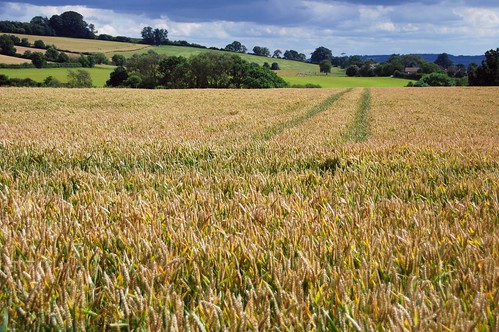
Just as breathtaking: the wheat fields right outside Hidcote Gardens.
But the highlight of our visit was Snowshill Lavendar Farm. It’s a pretty stunning sight to go from golden hills of wheat to acres and acres of vivid purple farmland. And the fragrance was incredible! You can pay a small entrance fee (£3?) to enter the farms and pick your own lavender, or you can just enjoy the lovely sight and aroma from the highway (like we did!).
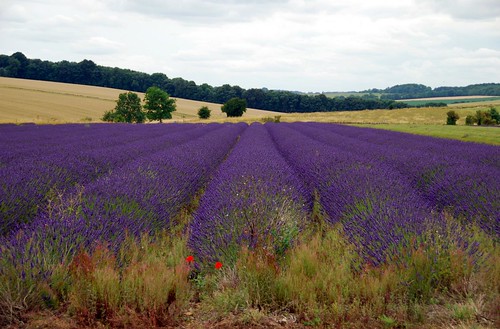
Snowshill Lavender: if only pictures could capture smell, too…
If you ever feel like walking straight into movies like Pride and Prejudice or Remains of the Day, now you know know exactly where to go. ![]()
Note: You may notice a few changes in the way I post about our travel experiences. Since so much of traveling is about the actual traveling part (and others may find this useful), I’ll be including a “How We Got from Point A to Point B” section at the end of each post. I’ll also be including info on where we stayed in each destination. Like a good (online) citizen, I’ve been updating Wikitravel, Tripadvisor, and Hostelbookers with reviews of the hotels and hostels where we’ve laid our heads, and I thought it might be a good idea to include those words here too. Hope it helps in your future travels!
How we got from Oxford to the Cotswolds: We drove our rental car along the A44 from Oxford to Moreton-in-Marsh, our first destination in the Cotswolds. It was a relatively straightforward drive (only about 1 hour), but we felt very fortunate to have Chi-Chi’s satellite navigation device with us—all those one-way streets and roundabouts in the England can throw you for a loop!
Where we slept in the Cotswolds: The first night, we stayed at Warwick House B&B (£60 for a double ensuite, including breakfast) in Moreton-in-Marsh. The owner, Charlie, is really sweet and totally crazy in that way that all B&B owners seem to be. We had the largest room in the house, with an attached ensuite bathroom (with a bathtub!). The room was great but the beds were a bit too soft for us.
The second night, we stayed at Little Broom (£55 for a double room ensuite, including breakfast) in Maugersbury, near Stow-in-the-Wold. It was a beautiful little cottage out in the countryside with incredible grounds and yet another crazy B&B owner. Our room was smaller (and pinker) than our room at the Warwick. Great breakfast!
After 10 days in London, we rented a car to explore the English and Welsh countryside. First stop: Oxford, where our friends Nas and Jen (who we know through Grace and Susan), agreed to host us for the evening, which was very generous, considering they have a (very cute) 9-month-old (Nya) to run around after!
I’m sure I can’t do Oxford justice, since we were there a mere 24 hours, but I’m pretty certain no one will argue that it is a beautiful place. Nas, Jen, and Nya walked us into town along the River Thames, and the countryside around their home was just stunning!
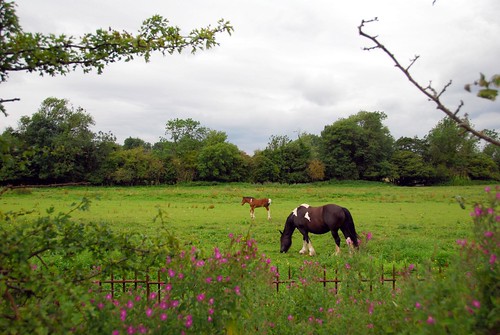
You might find this picture next to the word “idyllic” in the dictionary.
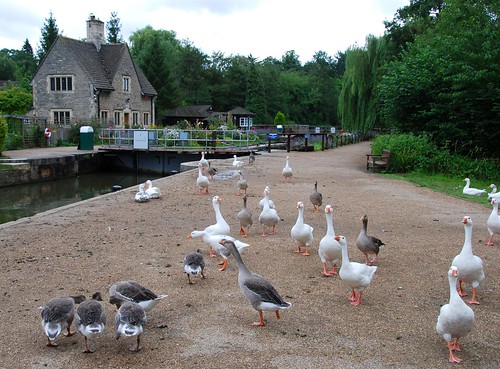
Ducks and geese vying for food in front of the Lockkeeper’s Cottage.
Once you get into town, the views are just as mesmerizing. If the gorgeous architecture doesn’t win you over, then the cobblestone streets surely will.

The Radcliffe Camera, probably the most photographed building in Oxford.
Speaking of gorgeous architecture, we thought the Natural History Museum in London was beautiful, but the equivalent in Oxford blows London out of the water! Sadly, the photos will not do the stunning Gothic structure justice.
Many people (including Jeremy and I) are surprised to hear that Oxford does not have a unified college campus, but rather, is made up of a number of independent colleges, each with its own identity and unique campus. By far the most popular is Christ Church College, since it houses The Dining Hall Where they Filmed Harry Potter. There were a lot of kids and teenagers touring Christ Church, each one probably imagining that they were flying around these hallowed halls on their own personal broomsticks.
To which I say: dining hall, schmining hall. Check out the ceiling!!! [SWOON.]
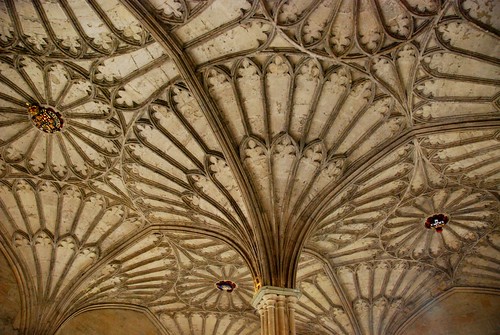
The ceiling in Christ Church College.
If you’re ever in Oxford, we highly recommend you check out the University Church of St. Mary the Virgin. The views of Oxford from the top are stunning! They recently upped the entry fee from £1 to £3, but it’s still worth it.
Our stopover in Oxford, although brief, was very enjoyable. Not only did we get to see England in all its glory (punting on the River Thames, historic university halls, people playing cricket, calves nursing in the grassy fields, old timey guys riding wooden bicycles in coattails…does it get more “English than that?!?), but Nas, who is a master photographer, filled our little brains up with all the f-stop and aperture info we could handle! We even had time for a late-night photo-shoot in his studio (check out the rest of his work here).
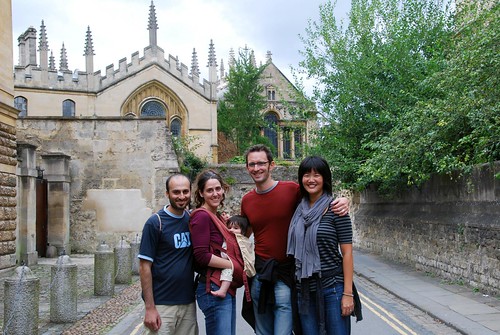
Nas, Jen, Nya, Jeremy, and Hope.
Thanks to Nas, Jen, and Nya for showing us such a beautiful part of the world!
